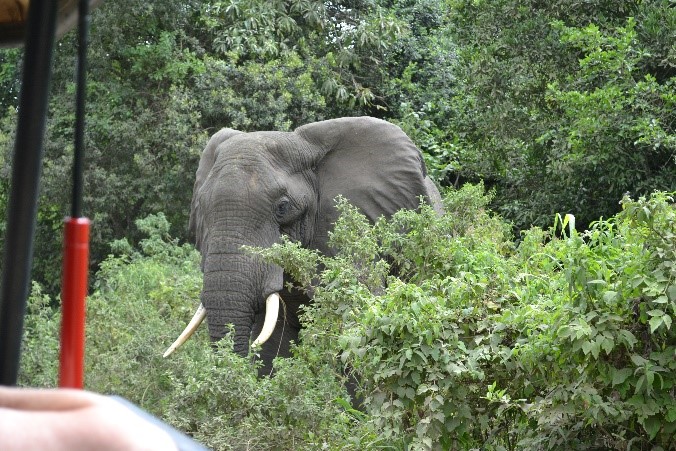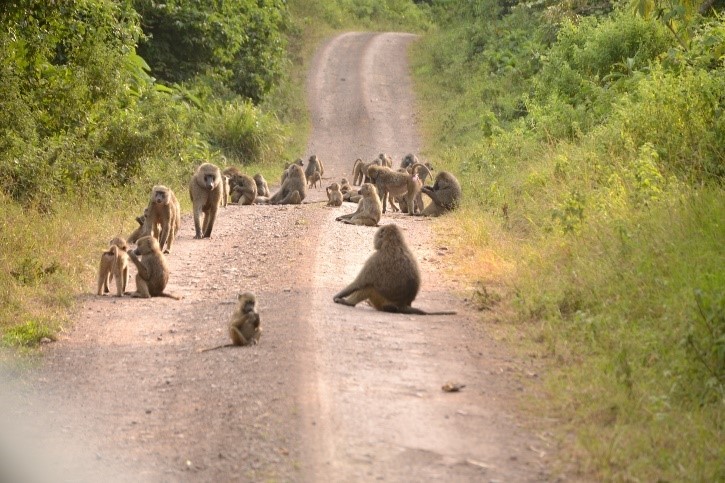
Picture this, you enter a national park in your jeep with your fantastic local guides and expert driver, you aren’t 15 minutes into the park and the driver, who somehow can see through the camouflage and spot animals with amazing aptitude, stops and points. Deep in the trees you see something very pure white and then you spot it too, there is an elephant attached to that tusk!

Oh my, it looks enormous! Everyone grabs their cameras to catch a picture and the elephant starts walking toward the road. He is a huge bull male, bigger than our 6 person jeep!

He walks down to the road, gets a bit anxious because our jeep is right in his path (we didn’t realize this at first) and wiggles his massive ears, raises his trunk in concern, then steps back.

He looks right at us and everyone in the jeep almost simultaneously says, “Did you hear that, he just spoke to us! He just asked us to move back!” It was an amazing feeling, his eyes were so sincere with the connection.

We turned on the engine, rolled back. He looked at us again, and then walked right across in front of us, turning as if to say thanks, and then crossing to the other side.
And this was the first 15 minutes into our 10 day safari trip!!
We drove on thinking, this won’t be beat, but yes, every day, something new would happen, a new interaction, a new amazing animal or bird, an event to watch between animals, sunsets, scenery, oh my! It got better every single minute!



We spent 10 days on safari in Tanzania. We explored Arusha National Park, Tarangire National Park, the Ngorongoro crater, ending with 3 days on the Serengeti. It was winter in Africa, so 70º in the day, dry weather, dusty driving, but you are so fascinated with what is happening in the savannah you don’t think much about it. The dust and washboard dirt roads, especially in the Serengeti seem endless, but worth it. Local reserves take great care not to bring huge tractors and machinery into the wildlife areas so they don’t disturb the natural environment. A bit of dust is a small price to pay. If you don’t like the dry, dust, travel on the shoulder seasons on either side of the rainy season. February is high season for Wildebeest calving.

A lot of other animals are delivering babies in this season as well. Late May into June is Wildebeest Migration which actually lasts until almost October because the Wildebeest and Zebra migrate though the Tanzanian Serengeti into Kenya and then back. Cooler weather in the winter months (summer for us in the Northern Hemisphere) are dry, great weather and great wild life viewing.
Here are some other amazing and fun adventures along throughout the ten day safari:
About 20-40 baboons sitting right in the middle of the road. They looked at us like they were laughing, “Tough luck tourists, you will have to wait!” Little did they know we enjoyed every minute of waiting. Then they raced off chasing each other, climbing trees, howling, playing, and gave us a sendoff from the treetops.



Our incredible driver with Superman vision, spotted a leopard high up on a rock outcropping, called Kopjes. He was laying there washing his paws. We were so excited to see him, they are quite elusive. And adding to our excitement, we arrived to see him BEFORE the rest of our group in the
other jeep. We were all ready for the “nah nah!” The leopard stood up, and wandered back behind the rock at the top and laid down out of sight. Next thing, the other jeep drives up. We were thinking, “oh too bad they missed everything.” Weirdly they kept standing up taking photos and we said to each other, what the heck are they photographing, they missed him. Then they started pointing to us and right in front of us, in the tree was the female leopard. She was so camouflaged into the tree bark we didn’t even see her there. All along we could have been getting real close up shots. That will teach us for trying to make the other jeep passengers jealous!

One afternoon we were heading back to camp to finally have a midday break for lunch. Every day our guides would say, we are going to do some wildlife viewing in the morning, leaving around 6:00am, then around noon we will head back to the camp, eat lunch and get a few hours of downtime to rest, then out again around 3:00pm until sundown. We NEVER did this, always too much to see and we would all vote for staying out and eating a box lunch out in the bush.
This day, we decided, definitely we are going to try the midday break. On the way back to camp, our driver stopped and said, look at that lioness, she is hunting those gazelle across the road. We sat for a few minutes and watched her, watching them. The other jeep decided, nope, we are heading back. We couldn’t resist, in our jeep, we voted to stay and see what this lioness would do. What a great decision!


It was an amazing dance! She would crouch down, watching, sleek forward in the tall grass, then sit and watch some more. The huge herd of gazelle just grazed, totally unaware. Then some starting walking toward the small pond. They stopped, aware of something, not seeing her. The lead gazelle, doubled back and most followed him/her back to the grassy area. The lioness waited. More gazelle started across again, going toward the water. Our guides, absolutely amazing at understanding wildlife behavior, said, “Don’t watch the lion, watch the gazelle.” We had our eyes glued into our cameras and binoculars. Our guides said, “Now!” and within seconds, the lioness caught a gazelle. Most of us missed it because there just wasn’t time to move our cameras and binoculars fast enough and refocus. Key learning, watch an amazing feat of nature with your eyes!

The beautiful lioness came out of the pond with the gazelle in her mouth. She was exhausted as their stamina is fast but short lived. Once the gazelle was dead, she put it down, panting. Then she carried it along, stopping every few feet to breath, until she got to the tall grass again and then she laid down. She needed to keep low and quiet because she was alone, but if her pride was near, the other females would likely come and take her lunch away. It was an unforgettable experience seeing the natural events in the wild. It seems sad when you watch on TV but in the wild, it is so clearly part of life. The lions take only what they need, eat it completely, the gazelles help the lions stay alive. The true circle of life in action.


From Wildebeest migration to hyenas causing a stampede, from elephants playing in the mud to hippo piles in small pools of water, from meeting the Maasai people to learning about first life on earth at the Leakey archeological site, every day was better than the last. A safari is truly a trip of a lifetime!


Recent Comments